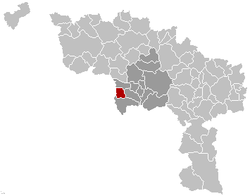Quievrain
| Quiévrain | |||
|---|---|---|---|
| Municipality | |||

Quiévrain: St Martin's church (16th century)
|
|||
|
|||
| Location in Belgium | |||
| Coordinates: 50°24′N 03°41′E / 50.400°N 3.683°ECoordinates: 50°24′N 03°41′E / 50.400°N 3.683°E | |||
| Country | Belgium | ||
| Community | French Community | ||
| Region | Wallonia | ||
| Province | Hainaut | ||
| Arrondissement | Mons | ||
| Government | |||
| • Mayor | Daniel Dorsimont (PS) | ||
| • Governing party/ies | PS, AC | ||
| Area | |||
| • Total | 21.22 km2 (8.19 sq mi) | ||
| Population (1 January 2016) | |||
| • Total | 6,715 | ||
| • Density | 320/km2 (820/sq mi) | ||
| Postal codes | 7380, 7382 | ||
| Area codes | 065 | ||
| Website | www.quievrain.be | ||
Quiévrain is a Walloon municipality located in the Belgian province of Hainaut. On 1 January 2006, the municipality had 6,559 inhabitants. The total area is 21.22 km², giving a population density of 309 inhabitants per km².
The municipality contains the following population centres: Quiévrain proper, Baisieux, and Audregnies.
Shortly after the French Revolution of 1848, Belgian migrant workers living in Paris were encouraged to return to Belgium to overthrow the monarchy and establish a republic. Around 6,000 émigrés, coming from Paris, formed the "Belgian Legion". The legion was armed by some of the administrative authorities of Lille, and intended to penetrate into Belgium to "raise the people" and overthrow the Belgian monarchy. It is likely that the revolutionaries had the support of the Minister of Foreign Affairs of the French Second Republic, which had only recently been installed and was still very militant.
The first group, travelling by train, was stopped and quickly disarmed at Quiévrain on 26 March 1848. The second group crossed into Belgium and was defeated in the Risquons-Tout incident.
...
Wikipedia




